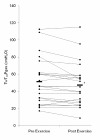Abdominal muscle fatigue following exercise in chronic obstructive pulmonary disease
- PMID: 20132549
- PMCID: PMC2824704
- DOI: 10.1186/1465-9921-11-15
Abdominal muscle fatigue following exercise in chronic obstructive pulmonary disease
Abstract
Background: In patients with chronic obstructive pulmonary disease, a restriction on maximum ventilatory capacity contributes to exercise limitation. It has been demonstrated that the diaphragm in COPD is relatively protected from fatigue during exercise. Because of expiratory flow limitation the abdominal muscles are activated early during exercise in COPD. This adds significantly to the work of breathing and may therefore contribute to exercise limitation. In healthy subjects, prior expiratory muscle fatigue has been shown itself to contribute to the development of quadriceps fatigue. It is not known whether fatigue of the abdominal muscles occurs during exercise in COPD.
Methods: Twitch gastric pressure (TwT10Pga), elicited by magnetic stimulation over the 10th thoracic vertebra and twitch transdiaphragmatic pressure (TwPdi), elicited by bilateral anterolateral magnetic phrenic nerve stimulation were measured before and after symptom-limited, incremental cycle ergometry in patients with COPD.
Results: Twenty-three COPD patients, with a mean (SD) FEV1 40.8(23.1)% predicted, achieved a mean peak workload of 53.5(15.9) W. Following exercise, TwT10Pga fell from 51.3(27.1) cmH2O to 47.4(25.2) cmH2O (p = 0.011). TwPdi did not change significantly; pre 17.0(6.4) cmH2O post 17.5(5.9) cmH2O (p = 0.7). Fatiguers, defined as having a fall TwT10Pga > or = 10% had significantly worse lung gas transfer, but did not differ in other exercise parameters.
Conclusions: In patients with COPD, abdominal muscle but not diaphragm fatigue develops following symptom limited incremental cycle ergometry. Further work is needed to establish whether abdominal muscle fatigue is relevant to exercise limitation in COPD, perhaps indirectly through an effect on quadriceps fatigability.
Figures
Similar articles
-
Respiratory muscle fatigue following exercise in patients with interstitial lung disease.Respiration. 2013;85(3):220-7. doi: 10.1159/000338787. Epub 2012 Jul 19. Respiration. 2013. PMID: 22813885
-
Quadriceps and respiratory muscle fatigue following high-intensity cycling in COPD patients.PLoS One. 2013 Dec 6;8(12):e83432. doi: 10.1371/journal.pone.0083432. eCollection 2013. PLoS One. 2013. PMID: 24324843 Free PMC article.
-
Impaired abdominal muscle contractility after high-intensity exhaustive exercise assessed by magnetic stimulation.Muscle Nerve. 2006 Oct;34(4):423-30. doi: 10.1002/mus.20599. Muscle Nerve. 2006. PMID: 16810695 Clinical Trial.
-
Respiratory muscle function and activation in chronic obstructive pulmonary disease.J Appl Physiol (1985). 2009 Aug;107(2):621-9. doi: 10.1152/japplphysiol.00163.2009. Epub 2009 Apr 23. J Appl Physiol (1985). 2009. PMID: 19390004 Review.
-
Respiratory and locomotor muscle blood flow during exercise in health and chronic obstructive pulmonary disease.Exp Physiol. 2020 Dec;105(12):1990-1996. doi: 10.1113/EP088104. Epub 2020 Mar 29. Exp Physiol. 2020. PMID: 32103536 Review.
Cited by
-
Dynamic laryngeal narrowing during exercise: a mechanism for generating intrinsic PEEP in COPD?Thorax. 2015 Mar;70(3):251-7. doi: 10.1136/thoraxjnl-2014-205940. Epub 2015 Jan 13. Thorax. 2015. PMID: 25586938 Free PMC article.
-
Significance of Patent Foramen Ovale in Patients with GOLD Stage II Chronic Obstructive Pulmonary Disease (COPD).Chronic Obstr Pulm Dis. 2014 Sep 25;1(2):185-192. doi: 10.15326/jcopdf.1.2.2013.0003. Chronic Obstr Pulm Dis. 2014. PMID: 28848820 Free PMC article.
-
Laryngeal widening and adequate ventilation by expiratory pressure load training improve aerobic capacity in COPD: a randomised controlled trial.Thorax. 2023 Dec 15;79(1):23-34. doi: 10.1136/thorax-2022-219755. Thorax. 2023. PMID: 37696622 Free PMC article. Clinical Trial.
-
Detection and diagnosis of large airway collapse: a systematic review.ERJ Open Res. 2021 Aug 9;7(3):00055-2021. doi: 10.1183/23120541.00055-2021. eCollection 2021 Jul. ERJ Open Res. 2021. PMID: 34381840 Free PMC article. Review.
-
Potential Role of Patent Foramen Ovale in Exacerbating Hypoxemia in Chronic Pulmonary Disease.Tex Heart Inst J. 2017 Jun 1;44(3):189-197. doi: 10.14503/THIJ-16-6027. eCollection 2017 Jun. Tex Heart Inst J. 2017. PMID: 28761399 Free PMC article. Review.
References
-
- NHLBI Workshop. Respiratory muscle fatigue. Report of the Respiratory Muscle Fatigue Workshop Group. Am Rev Respir Dis. 1990;142:474–480. - PubMed
-
- American Thoracic Society/European Respiratory Society. Skeletal muscle dysfunction in chronic obstructive pulmonary disease. A statement of the American Thoracic Society and European Respiratory Society. Am J Respir Crit Care Med. 1999;159:S1–40. - PubMed
Publication types
MeSH terms
Grants and funding
LinkOut - more resources
Full Text Sources
Other Literature Sources
Medical


